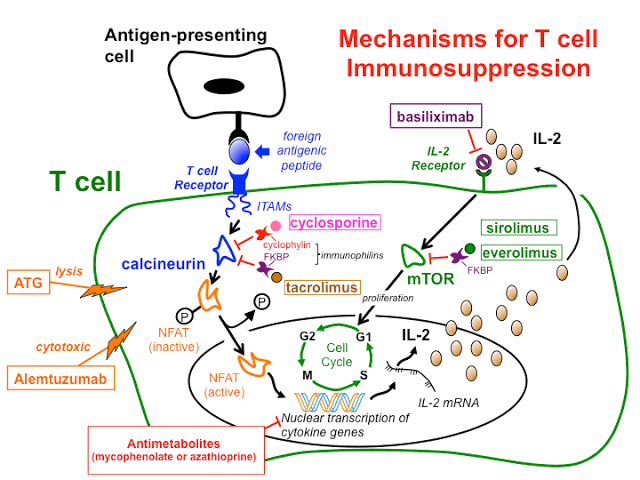
Cyclosporine (CsA) and Tacrolimus
Cyclosporine (CsA) and tacrolimus are potent immunosuppressant drugs widely used in transplantation medicine to prevent organ rejection. While both achieve a similar clinical effect, they possess distinct chemical structures, mechanisms of action, and pharmacokinetic profiles. This guide provides a detailed overview of these aspects, along with key clinical considerations for their use.
Chemical Structure of Cyclosporine and Tacrolimus
- Cyclosporine A (CsA): CsA is a cyclic undecapeptide consisting of 11 amino acids. It is a neutral, hydrophobic molecule, which contributes to its limited water solubility and bioavailability. Its chemical formula is C62H111N11O12, and its molecular weight is approximately 1203 Da.
- Tacrolimus (FK506): Tacrolimus is a macrolide lactone, a structurally distinct compound from CsA. It has the chemical formula C44H69NO12 and a molecular weight of approximately 804 Da. Like CsA, tacrolimus is also hydrophobic but generally exhibits better bioavailability compared to CsA.
Mechanism of Action: A Tale of Two Immunophilins
Both CsA and tacrolimus exert their immunosuppressive effects by inhibiting the calcineurin pathway, a critical signaling cascade in T-lymphocytes. However, they achieve this inhibition by binding to different intracellular proteins known as immunophilins.
- Cyclosporine’s Dance with Cyclophilin: CsA binds to cyclophilin, specifically cyclophilin A, an abundant cytosolic protein. The CsA-cyclophilin complex then interacts with calcineurin, preventing its activation.
- Tacrolimus’s Affinity for FKBP12: Tacrolimus, on the other hand, binds to FK506-binding protein 12 (FKBP12), another intracellular immunophilin. The tacrolimus-FKBP12 complex also inhibits calcineurin, albeit at a different binding site than the CsA-cyclophilin complex.
Calcineurin: The Phosphatase at the Heart of T-Cell Activation
Calcineurin is a calcium- and calmodulin-dependent serine/threonine protein phosphatase. It plays a crucial role in T-cell activation by dephosphorylating the nuclear factor of activated T-cells (NFAT). In its phosphorylated state, NFAT remains in the cytoplasm. Upon T-cell receptor stimulation, intracellular calcium levels rise, activating calcineurin. Activated calcineurin dephosphorylates NFAT, allowing it to translocate to the nucleus. Once in the nucleus, NFAT binds to DNA and promotes the transcription of genes encoding cytokines such as interleukin-2 (IL-2), a key growth factor for T-cells. By inhibiting calcineurin, both CsA and tacrolimus block NFAT dephosphorylation and subsequent IL-2 production, effectively suppressing T-cell activation and proliferation.
Target Trough Levels in Transplantation
Monitoring drug levels is crucial for optimizing immunosuppression and minimizing toxicity. Trough levels, measured just before the next dose, are commonly used to guide dosing adjustments.
- Renal Transplantation:
- Early Period (0-3 months post-transplant):
- CsA: 150-250 ng/mL
- Tacrolimus: 8-12 ng/mL
- Late Period ( >3 months post-transplant):
- CsA: 100-200 ng/mL
- Tacrolimus: 5-10 ng/mL
- Early Period (0-3 months post-transplant):
- Pancreas Transplantation: Target trough levels are generally similar to those for renal transplantation, with a tendency towards the higher end of the range in the early post-transplant period due to the increased risk of rejection.
- Liver Transplantation:
- Early Period (0-3 months post-transplant):
- CsA: 200-300 ng/mL
- Tacrolimus: 8-12 ng/mL
- Late Period (>3 months post-transplant):
- CsA: 100-200 ng/mL
- Tacrolimus: 5-10 ng/mL
Note: Target trough levels can vary based on individual patient factors, the specific assay used by the laboratory, and the presence of other immunosuppressants in the regimen.
- Early Period (0-3 months post-transplant):
Cytochrome P450 3A4 (CYP3A4) Interactions
Both CsA and tacrolimus are metabolized by the cytochrome P450 3A4 (CYP3A4) enzyme system, primarily in the liver and intestines. This makes them susceptible to drug interactions with agents that act as CYP3A4 substrates, inhibitors, or inducers.
- CYP3A4 Inhibitors: These drugs decrease the activity of CYP3A4, leading to increased CsA and tacrolimus levels, potentially causing toxicity. Common examples include:
- Azole antifungals (e.g., ketoconazole, itraconazole, voriconazole)
- Macrolide antibiotics (e.g., erythromycin, clarithromycin)
- Calcium channel blockers (e.g., diltiazem, verapamil)
- HIV protease inhibitors (e.g., ritonavir)
- Grapefruit juice
- CYP3A4 Inducers: These drugs increase the activity of CYP3A4, leading to decreased CsA and tacrolimus levels, potentially causing rejection. Common examples include:
- Anticonvulsants (e.g., phenytoin, carbamazepine, phenobarbital)
- Rifamycins (e.g., rifampin, rifabutin)
- St. John’s Wort
- CYP3A4 Substrates: These drugs compete with CsA and tacrolimus for metabolism by CYP3A4, potentially affecting the levels of both drugs. Examples include:
- Statins (e.g., simvastatin, atorvastatin)
- Calcium channel blockers (e.g. nifedipine)
- Corticosteroids
Common Clinical Side Effects
While CsA and tacrolimus are effective immunosuppressants, they are associated with a range of potential side effects.
- Nephrotoxicity: Both drugs can cause dose-dependent nephrotoxicity, characterized by elevated serum creatinine and decreased glomerular filtration rate. Chronic nephrotoxicity can lead to irreversible kidney damage.
- Neurotoxicity: Neurological side effects are common, including tremor, headache, paresthesias, and, less frequently, seizures, encephalopathy, and posterior reversible encephalopathy syndrome (PRES).
- Hypertension: Both drugs can cause or exacerbate hypertension, often requiring antihypertensive medications.
- Hyperlipidemia: Elevated cholesterol and triglyceride levels are frequently observed.
- Glucose Intolerance/Diabetes Mellitus: Both drugs can impair glucose metabolism, leading to new-onset diabetes after transplantation (NODAT). Tacrolimus is generally considered to have a higher risk of NODAT compared to CsA.
- Gastrointestinal Disturbances: Nausea, vomiting, diarrhea, and abdominal pain are common, especially at higher doses.
- Electrolyte Imbalances: Hypomagnesemia, hypokalemia, and hyperkalemia can occur.
- Cosmetic Effects: Hirsutism (excessive hair growth) is more common with CsA, while alopecia (hair loss) is more frequently seen with tacrolimus. Gingival hyperplasia (gum overgrowth) is a characteristic side effect of CsA.
- Increased Risk of Infection and Malignancy: Due to their immunosuppressive effects, both drugs increase the risk of opportunistic infections (e.g., cytomegalovirus, Pneumocystis jirovecii) and certain malignancies, such as skin cancer and post-transplant lymphoproliferative disorder (PTLD).
Conclusion
CsA and tacrolimus are essential immunosuppressants in transplantation. Understanding their chemical structures, mechanisms of action, pharmacokinetic properties, and potential side effects is crucial for optimizing their use and ensuring the best possible outcomes for transplant recipients. Careful monitoring of drug levels, awareness of potential drug interactions, and proactive management of side effects are essential components of patient care.







